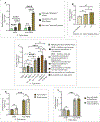Fecal Shedding, Antimicrobial Resistance and In Vitro Biofilm formation on Simulated Gallstones by Salmonella Typhi Isolated from Typhoid Cases and Asymptomatic Carriers in Nairobi, Kenya
- PMID: 39319013
- PMCID: PMC11421374
- DOI: 10.14302/issn.2690-4721.ijcm-24-5030
Fecal Shedding, Antimicrobial Resistance and In Vitro Biofilm formation on Simulated Gallstones by Salmonella Typhi Isolated from Typhoid Cases and Asymptomatic Carriers in Nairobi, Kenya
Abstract
Typhoid fever, caused by the human restricted pathogen Salmonella Typhi, remains a major global public health concern. Even after successful treatment, approximately 3-5% of patients with typhoid fail to clear the bacteria within one year and become chronic carriers. Most typhoid carriers have gallstones in their gallbladder, and biofilm formation on gallstones is highly correlated with chronic carriage. This study's goal was to identify asymptomatic typhoid carriers in an endemic setting in Kenya, and to compare acute versus chronic isolates. A cohort of typhoid fever patients identified through blood and/or stool culture, and their household contacts, were followed up after treatment to detect longitudinal S. Typhi stool shedding. An abdominal ultrasound scan was used to identify individuals with gallstones. A total of 32 index patients and 32 household contacts were successfully followed-up. Gallstones were detected in 4 cases and 1 household contact. The duration of S. Typhi shedding was significantly longer in individuals with gallstones compared to those without, P<0.001. Eighty-three (83) S. Typhi strains were tested for susceptibility to commonly used antimicrobials and examined by in vitro biofilm formation assays. Out of 37 infected individuals, 32.4% had infections caused by multidrug resistant (MDR) S. Typhi strains and only 18.9% were infected by susceptible strains. Non-MDR strains formed significantly better biofilms in vitro than the MDR strains (P<0.001). This study provides data on S. Typhi chronic carriage that will influence public health approaches aimed at reducing typhoid transmission and the burden of infection.
Keywords: AMR; Salmonella; antibiotics; biofilm; typhoid.
Conflict of interest statement
Conflict of Interest The authors declare that they have no competing interests.
Figures


Similar articles
-
Salmonella Typhi Haplotype 58 biofilm formation and genetic variation in isolates from typhoid fever patients with gallstones in an endemic setting in Kenya.Front Cell Infect Microbiol. 2024 Nov 13;14:1468866. doi: 10.3389/fcimb.2024.1468866. eCollection 2024. Front Cell Infect Microbiol. 2024. PMID: 39606745 Free PMC article.
-
Genomic insights into the role of Salmonella Typhi carriers in antimicrobial resistance and typhoid transmission in Urban Kenya.PLoS One. 2025 May 28;20(5):e0321879. doi: 10.1371/journal.pone.0321879. eCollection 2025. PLoS One. 2025. PMID: 40434987 Free PMC article.
-
Salmonella Typhi Haplotype 58 (H58) Biofilm Formation and Genetic Variation in Typhoid Fever Patients with Gallstones in an Endemic Setting in Kenya.medRxiv [Preprint]. 2024 Jun 4:2024.06.03.24308409. doi: 10.1101/2024.06.03.24308409. medRxiv. 2024. Update in: Front Cell Infect Microbiol. 2024 Nov 13;14:1468866. doi: 10.3389/fcimb.2024.1468866. PMID: 38883710 Free PMC article. Updated. Preprint.
-
Biofilm Producing Salmonella Typhi: Chronic Colonization and Development of Gallbladder Cancer.Int J Mol Sci. 2017 Aug 31;18(9):1887. doi: 10.3390/ijms18091887. Int J Mol Sci. 2017. PMID: 28858232 Free PMC article. Review.
-
Chronic Salmonella Typhi carriage at sites other than the gallbladder.PLoS Negl Trop Dis. 2023 Mar 23;17(3):e0011168. doi: 10.1371/journal.pntd.0011168. eCollection 2023 Mar. PLoS Negl Trop Dis. 2023. PMID: 36952437 Free PMC article. Review.
Cited by
-
Salmonella Typhi Haplotype 58 biofilm formation and genetic variation in isolates from typhoid fever patients with gallstones in an endemic setting in Kenya.Front Cell Infect Microbiol. 2024 Nov 13;14:1468866. doi: 10.3389/fcimb.2024.1468866. eCollection 2024. Front Cell Infect Microbiol. 2024. PMID: 39606745 Free PMC article.
-
Genomic insights into the role of Salmonella Typhi carriers in antimicrobial resistance and typhoid transmission in Urban Kenya.PLoS One. 2025 May 28;20(5):e0321879. doi: 10.1371/journal.pone.0321879. eCollection 2025. PLoS One. 2025. PMID: 40434987 Free PMC article.
-
Shigellosis in an Urban Slum in Kenya: Risk Factors and Antimicrobial Resistance.Open Forum Infect Dis. 2025 Jan 18;12(2):ofaf026. doi: 10.1093/ofid/ofaf026. eCollection 2025 Feb. Open Forum Infect Dis. 2025. PMID: 39963694 Free PMC article.
-
Antimicrobial resistance and biofilm formation in rarely reported Salmonella enterica serovars from patients presenting with gastroenteritis in Nairobi, Kenya.Front Microbiol. 2025 Jun 25;16:1628784. doi: 10.3389/fmicb.2025.1628784. eCollection 2025. Front Microbiol. 2025. PMID: 40636486 Free PMC article.
-
Salmonella Typhi Haplotype 58 (H58) Biofilm Formation and Genetic Variation in Typhoid Fever Patients with Gallstones in an Endemic Setting in Kenya.medRxiv [Preprint]. 2024 Jun 4:2024.06.03.24308409. doi: 10.1101/2024.06.03.24308409. medRxiv. 2024. Update in: Front Cell Infect Microbiol. 2024 Nov 13;14:1468866. doi: 10.3389/fcimb.2024.1468866. PMID: 38883710 Free PMC article. Updated. Preprint.
References
-
- Parkhill J, Dougan G, James K, et al. (2001) Thomson N, Pickard D, Wain J, et al. Complete genome sequence of a multiple drug resistant Salmonella enterica serovar Typhi CT18. Nature. 413 (6858), 848–52. - PubMed
-
- World Health Organization. Typhoid 2018. Available from: https://www.who.int/news-room/fact-sheets/detail/typhoid. Accessed March 2024.
Grants and funding
LinkOut - more resources
Full Text Sources
